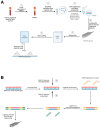From Sanger to Oxford Nanopore MinION Technology: The Impact of Third-Generation Sequencing on Genetic Hematological Diagnosis
- PMID: 40507293
- PMCID: PMC12153771
- DOI: 10.3390/cancers17111811
From Sanger to Oxford Nanopore MinION Technology: The Impact of Third-Generation Sequencing on Genetic Hematological Diagnosis
Abstract
Background: Sanger sequencing remains the gold standard for characterizing genetic variants in short DNA fragments (<700 bp). However, the increasing demand for short TATs and high sensitivities in variant detection, particularly in oncohematology, is driving the need for more efficient methods. Next-generation sequencing (NGS) has improved sensitivity and allows for the simultaneous analysis of multiple genes, but it is still costly and time-consuming. Consequently, Sanger sequencing continues to be widely used. In this study, we have compared Sanger sequencing with Oxford Nanopore technology (ONT), which offers enhanced sensitivity and faster sequencing, delivering diagnostic results within 24 h.
Methods: This study involves 164 samples (for a total of 174 analyzed regions of interest) previously characterized using either Sanger sequencing or a next-generation sequencing (NGS) panel, categorized by their genetic alterations. Validation was conducted on 15 genes crucial for the diagnosis, prognosis, or identification of drug resistance in myeloproliferative neoplasms (MPN), myelodysplastic syndromes (MDS), acute myeloid leukemia (AML), and chronic myeloid leukemia (CML). The primary objective was to assess whether MinION could identify the same variants previously detected in these patients.
Results and conclusions: With a 99.43% concordance observed in our comparison, our results support the implementation of MinION technology in routine variant detection in MPN, MDS, AML, and CML cases due to its significant advantages over Sanger sequencing.
Keywords: B-cell chronic lymphocytic leukemia; MinION technology; Oxford Nanopore MinION device; Sanger sequencing; acute myeloid leukemia; chronic myeloid leukemia; mutational analysis; myelodysplastic syndromes; myeloproliferative neoplasms; oncohematology.
Figures


References
LinkOut - more resources
Full Text Sources
Research Materials
Miscellaneous

